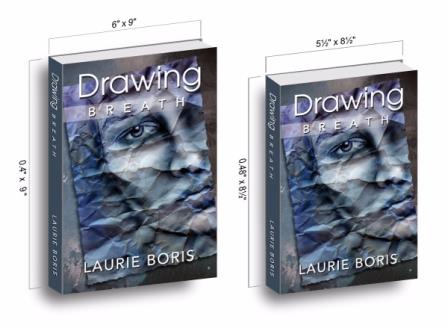 A quick spin through Mama Google tells authors and indie publishers pretty much everything they want to know about choosing the appropriate book size, usually called trim size. Sources mention that most self-published books range from 5″ x 8″ to 6″ x 9″, and often books that depend on images, like children’s picture books, cookbooks, and “coffee table” style books are larger, as are reference manuals and workbooks.
A quick spin through Mama Google tells authors and indie publishers pretty much everything they want to know about choosing the appropriate book size, usually called trim size. Sources mention that most self-published books range from 5″ x 8″ to 6″ x 9″, and often books that depend on images, like children’s picture books, cookbooks, and “coffee table” style books are larger, as are reference manuals and workbooks.
In choosing a book size, authors and publishers usually factor in cost, distribution limitations, and other technical matters. Authors are quick to offer their opinions, and our own Melissa Bowersock has written a helpful primer on formatting your print book. But what do readers want? What do they think is handiest, most comfortable for reading, easiest to carry around? So I asked a bunch. This report is by no means scientific, but I think I got to a decent cross-section of readers. Here’s what they told me.
Mass-market paperbacks (4.25″ x 7″) — These are the usual suspects lining shelves at the grocery store and airport shops, and they got the most mixed reviews. Readers liked that mass-market paperbacks are relatively inexpensive and handy for traveling. They fit nicely in a pocket or purse, but many disliked the too-small font sizes and the difficulty of holding them open. This was a particular problem for readers with arthritis.
Hardcovers were the general preference for beloved works that readers want to keep on their bookshelves, but several people (myself included) reported some unfortunate falling-asleep-book-in-face mishaps. Those Harry Potter books are blinkin’ heavy and can really leave a mark.
Trade paperbacks grabbed the most votes, as long as the fonts aren’t ridiculously small. These are larger-sized paperbacks, and that size can vary widely, but most range from 5.5″ x 8.5″ to 6″ x 9″. Most self-published POD (print on demand) books come in this flavor. What you choose as an author usually depends on personal preference and printing costs, and for some reason I couldn’t readily fathom, some sources claim that smaller sizes are better for novels and larger ones are more appropriate for nonfiction.
Among the trade paperback sizes, reader preference was divided. Some liked the portability and the “classier” look of the smaller dimensions. Some found 6″ x 9″ a little unwieldy. Since my first novel was published at 6″ x 9″, I kept using the same size so my books would sit tidily on a shelf together and look uniform when I display them at public events. In general, though, the trim size that offers the most pleasant reading experience sometimes depends on the length of the book. A very long book in a smaller trim size could make for an awkward, chunky product. That’s why a long novel is often “better” in a 6″ x 9″ format.
Conversely, a shorter text could benefit from a smaller size and could even make the difference between having a spine or not. For instance, if you publish with CreateSpace and your book has less than 130 pages, their website suggest a blank spine, which might not be desirable if you aspire to a bookstore shelf. There are only so many people you can talk into stalking the bookstores and turning your title cover-side out.
Anyway…let’s look at how page count factors into the best trim size for your needs.
Thanks to Fiona Raven, book designer, here’s a little formula to estimate page count at the two most common trade-paperback sizes. This is an approximation, and it will vary depending on the font size you choose and your margins. These figures are based on using Garamond at 11 point (I prefer 12 point for my books), with standard margins and standard line spacing.
5.5″ x 8.5″: Your word count divided by 390 = page count
For example: 80,000 divided by 390 = 205.13 pages (round that up to 206)
6″ x 9″: Your word count divided by 475 = page count
For example: 80,000 divided by 475 = 168.42 pages (round that up to 170)
Don’t forget to add a few pages for your front and back matter. I’m using eight pages for our purposes. That gives us a page count of 214 versus 178.
Given that CreateSpace’s formula for spine width is (page count) x (0.002252 for white paper), our 6″ x 9″ book would have a spine of about 0.4 inches, and our 5.5″ x 8.5″ book would have a spine around 0.48 inches wide. This might not sound like much of a difference on paper (sorry about that), but in execution, the look is very subtle.
Here’s a side-by-side comparison. I sweet-talked my art department into creating this little mock-up showing what one of my 6″ x 9″ books might look like at 5.5″ x 8.5″. I think “reader me” prefers the smaller size. And that’s what it’s all about, right? If you’re having doubts, why not ask a few readers?
The only conclusive conclusion I could draw about reader preference from my completely unscientific poll is that there are about as many reasons for liking (or disliking) a book size as there are readers. But a pleasant reading experience, like good design, is one that doesn’t call attention to itself in any negative or jarring way.
So, what do you think? As a reader, what’s your preference and why?

Interesting. I’d gone with 6×9, because it was suggested and a bit cheaper to print. But, I’ve never done a comparison or asked readers. You’ve raised lots of interesting points to consider.
As I will be embarking on my first self-publishing journey very soon, I found this to be SUCH useful information! And a factor I hadn’t considered before. Thanks, Laurie, for sharing this nugget of wisdom.
I find 5 x 8 looks better for 65k-75k word novels and everything below. 6 x 9 should be saved for really big books, and even then I find the format uncomfortable to handle.
Thanks for a thought-provoking article!
Thanks for the timely article, Laurie. I’m still wrestling with whether to put out a paperback version of my latest book, as it’s pretty short. Hadn’t thought about shifting down in trim size. That might make it doable. 🙂
It might make the difference, Lynne!
After playing around with it tonight, I think this is the answer. Genius! Thanks again! 🙂
I’m firmly in the 5.5×8 camp. When I first started, I wanted to have my thrillers in MMPB size–complete with lighter weight (dare I say flimsy?) pages. When I couldn’t find that, I went with the next “normal” size. Not sure why I started with white paper, but have now gone to cream, which I’m very happy with. Also started with glossy covers (still trying to achieve that MMPB feel 🙂 ), but have now gone over to matte, with similar happiness. Personally, when I see a 6×9 book I think literary fiction or non-fiction, but that could just be me.
I might go to that smaller size for the next one, DV, and the cream paper. The matte is nice, but some of my covers work better with one or the other. Funny about that 6×9 perception. I never really thought about it much as a reader.
I’ve always used 6″x9″ for my longer books, but 5.5″x8.5″ for my shorter ones. I generally go by the page count, opting for 200-500 pages if possible. I go for the Goldilocks formula–not too thin, not too fat.
Sounds like a good plan, Melissa.
I always use 5×8 for my books. I find the 6×9 more difficult to handle even though I actually own several books i that size because of the trade paperback releases.
When calculating page length it’s a good idea to factor in blank pages. Chapters ought always start on an odd numbered (ie right hand) page. That means that when a chapter ends on an odd page you need to add a blank page to force the next chapter to start on an odd numbered page.
Thank you for reminding me, Frank! I do the same for my books.
Thanks for the info, Laurie! Shared and pinned. 🙂
Thanks, Laurie. Having the two books together shows me I like the smaller size as well.
What’s my preference?
Kindle!
But if I ever get around to doing a Createspace paperback I’ll refer back to this post. I particularly liked the Drawing Breath vs Drawing Breath mockup. Sometimes seeing is the only way to get a real idea of how something will turn out. Thanks, Laurie, and thanks to your art department too. 🙂
Page count matters. When I first did L.A. Punk Rocker in 6 x 9 with 146 pages the book looked more like a magazine than a book. It was silly. The small size made all the difference. Now I think it looks the way it should. Like a proper paperback! Yay. Sometimes you don’t know until you get your proof back but I like this size for my other books too. Now that I am looking close, I think white pages were not the best call. Might consider changing to the cream. Yes, indeed. 🙂
Nice post Laurie and thank the art department for me as well.
Thanks, Brenda! It’s true that sometimes you just have to see it to know.
I prefer the smaller, trade paperback size. It’s what I’m used to seeing, but also it IS easier to pop into a handbag. I really appreciate the math you put in the article! Bookmarking this one. 🙂